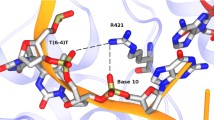Abstract
In this work, molecular dynamics (MD) simulations were performed on a DNA photolyase protein with two cofactors, FAD (flavin adenine dinucleotide) and MTHF (methenyltetrahydrofolate), inside the enzyme pocket. A DNA photolyase is a highly efficient light-driven enzyme that repairs the UV-induced cyclobutane-pyrimidine dimer in damaged DNA. We were aimed to compare the conformational changes of the FAD cofactor and other constituent fragments of the molecular system under consideration. The conformational behavior of the FAD molecule is very important for understanding the functional and structural properties of the DNA repair protein photolyase. The photoactive FAD is an essential cofactor both for specificial binding to damaged DNA and for catalysis. The second chromophore (MTHF or 8-HDF) is not necessary for catalysis and has no effect on specific enzyme—substrate binding. The obtained results were discussed to gain insight into the light-driven mechanism of DNA repair by a DNA photolyase enzyme—based on the enzyme structure, the FAD mobility, and conformation shape.
Similar content being viewed by others
References
M. Gleiser, “From cosmos to intelligent life: The four ages of astrobiology,” http://arxiv.org/abs/1202.5042.
A. Sancar, Chem. Rev. 103, 2203–2237 (2003).
T. Tamada, et al., Nat. Struct. Biol. 4(11), 887–891 (1997); doi: 10.1038/nsb1197-887.
J. Antony, D. Medvedev, and A. Stuchebrukhov, J. Am. Chem. Soc. 122, 1057–1065 (2000).
A. Mees, et al., Science 306, 1724 (2004); doi: 10.1126/science.1101598.
I. Oberpichler, et al., PLoS ONE 6(10), P.e26775 (2011); doi: 10.1371/journal.pone.0026775.
J. I. Lucas-Lledó and M. Lynch, Mol. Biol. Evol. 26(5), 1143–1153 (2009); doi: 10.1093/molbev/msp029.
C. P. Selby and A. Sancar, PNAS 103(47), 17696–17700 (2006); doi: 10.1073/pnas.0607993103.
F. Liu, et al., Sensors 8, 8453–8462 (2008); doi: 10.3390/s8128453.
J. Hahn, M.-E. Michel-Beyerle, and N. Rosch, J. Mol. Model. 4, 73–82 (1998); doi: 10.1007/s008940050133.
P. A. Karplus and G. E. Schulz, J. Mol. Biology 195(3), 701–729 (1987); http://dx.doi.org/10.1016/0022-2836(87)90191-4.
C. L. Thompson and A. Sancar, Oncogene 21, 9043–9056 (2002).
P. K. Verma and S. K. Pal, Eur. Phys. J. D 60, 137–156 (2010).
H.-W. Park, et al., Science 268, 1866 (1995).
Guobin Luo, et al., J. Phys. Chem. B 110(19), 9363–9367 (2006).
Y. Wang, P. P. Gasper, and J. S. Taylor, J. Am. Chem. Soc. 122, 5510 (2000).
F. Masson, et al., Chem. Phys. Chem. 10, 400–410 (2009).
D. A. Pearlman, et al., Comp. Phys. Commun. 91, 1–41 (1995).
D. C. Case, et al., AMBER, 2010.
U. Essmann, et al., J. Chem. Phys. 103, 8577–8592 (1995).
K. Kholmurodov, et al., J. Comp. Chem. 21(13), 1187–1191 (2000).
J. W. Ponder and D. A. Case, Adv. Prot. Chem. 66, 27–85 (2003).
W. D. Cornell, et al., J. Am. Chem. Soc. 117, 5179–5197 (1995).
W. L. Jorgensen, J. Chandrasekhar, and J. D. Madura, J. Chem. Phys. 79, 926–935 (1983).
H. J. C. Berendsen, et al., J. Chem. Phys. 81, 3684–3690 (1984).
J. P. Ryckaert, G. Ciccotti, and H. J. C. Berendsen, J. Comp. Phys. 23, 327–341 (1997).
R. A. Sayle and E. J. Milner-White, “RasMol: biomolecular graphics for all,” Trends in Biochem. Sci. 20, 374–376 (1995).
R. Koradi, M. Billeter, and K. Wuthrich, J. Mol. Graphics 4, 51–55 (1996).
W. Humphrey, A. Dalke, and K. Schulten, “VMD—visual molecular dynamics,” Ibid., 33–38.
T. Mirzadegan, et al., Biochemistry 42, 2759–2767 (2003).
U. Gether and B. K. Kobilka, J. Biol. Chem. 273, 17979–17982 (1998).
K. Palczewski, et al., Science 289, 739–745 (2000).
T. Okada, et al., J. Mol. Biol. 342, 571–583 (2004).
G. F. J. Salgado, et al., Biochemistry 43, 12819–12828 (2004).
D. C. Teller, et al., Biochemistry 40, 7761–7772 (2001).
Kh. T. Kholmurodov, T. B. Feldman, and M. A. Ostrovskii, Neuroscience and Behavioral Physiology 37(2), 161–174 (2007).
Author information
Authors and Affiliations
Additional information
The article is published in the original.
Rights and permissions
About this article
Cite this article
Dushanov, E., Kholmurodov, K., Yasuoka, K. et al. MD studies on conformational behavior of a DNA photolyase enzyme. Phys. Part. Nuclei Lett. 10, 597–605 (2013). https://doi.org/10.1134/S1547477113060101
Published:
Issue Date:
DOI: https://doi.org/10.1134/S1547477113060101




